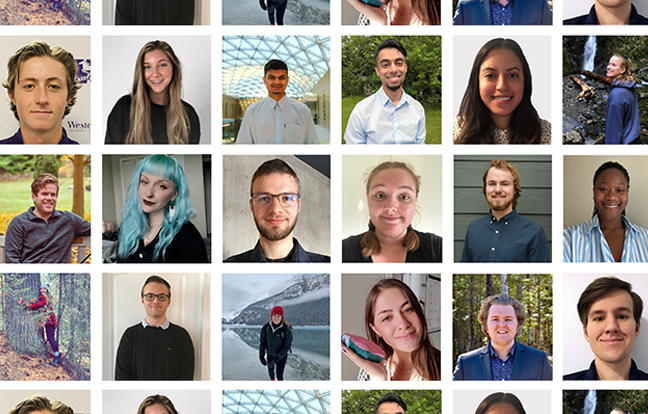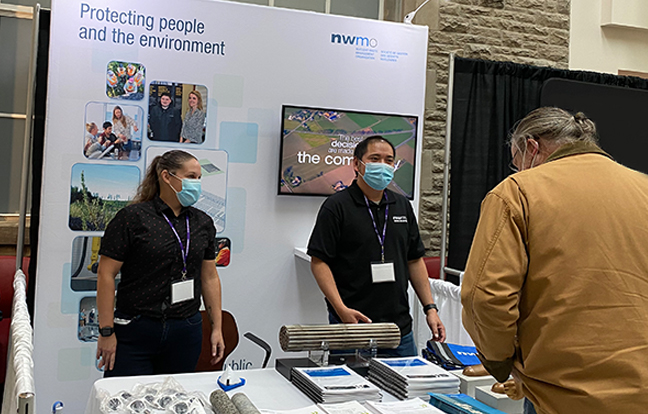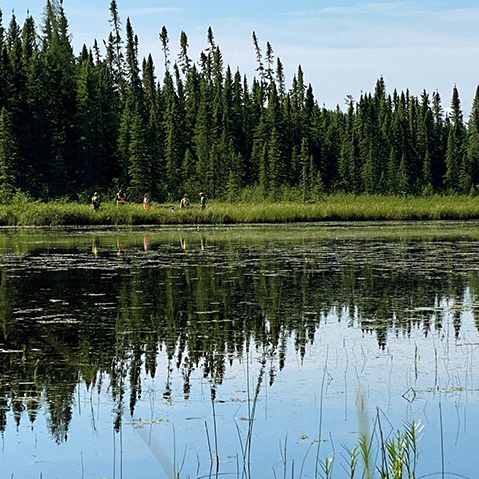Organizational readiness
The selection and announcement of the preferred site for the deep geological repository in 2023 will trigger a new phase of operations for the NWMO. This will require the NWMO to ensure we are properly resourced to carry out our responsibilities in advance of site selection and to fulfil the many new tasks that will follow that decision such as detailed site characterization, making regulatory submissions, and constructing and operating the deep geological repository. Preparations for that future are well underway.

The NWMO welcomed 18 students in 2021 as we continue our student program and our support for youth education, in particular, experiences in the fields of science, technology, engineering and mathematics.
Human resources
One of the most important resources we have at the NWMO is the talented people who drive our work forward. The scope and complexity of the project means it is essential that our staff are supported, trained and ready for each upcoming phase of work, through site selection and beyond.
In 2021, the Human Resources (HR) team launched an extensive recruitment process to ensure alignment and competence relative to our organizational objectives that included promotions, restructuring, new hires and student placements. The HR team supported the business resources plan through job design, evaluation and recruitment of 35 new employees, including 18 students. These internships are an important way we engage youth and develop the skills capacity that will be necessary to support our multi-generational project.
These changes and new roles are part of a talent attraction and retention strategy that will ensure we have the right people in key roles to reach site selection. The HR team also advanced the workforce planning and mobilization strategy for the post–site-selection phase when we will begin moving our operations to the site.
To ensure our staff are continuing to develop their skills capacity, we also implemented the NWMO-U training management system and conducted several staff and leadership training sessions as part of our multi-year organizational learning plan. Since our project will span generations, it is important that we develop a learning culture adept at knowledge transfer.
The NWMO also took additional steps to drive an organization-wide culture shift that supports our strategic plan and corporate values. We did this by identifying and developing cultural competencies supported by organizational behaviours and standards, as well as corporate tools, which will be key to executing future phases of the project.
We value diversity in all disciplines and at all levels of the organization. In 2021, the HR team bolstered its ongoing work to build an equitable, diverse and inclusive workforce by partnering with key organizations that support and drive actions and best practices such as Electricity Human Resources Canada and the Canadian Centre for Diversity and Inclusion. The NWMO also signed on to the Thunder Bay Anti-Racism and Inclusion Accord.
Training was provided to the entire organization on fundamental equity, diversity and inclusion concepts to support our commitment to maintain a workforce free of direct, indirect and systemic discrimination, and to increase representation from under-represented and designated groups.
To further support these efforts, in 2021, two governing documents – our Recruitment Procedure and the Whistleblower Policy/Procedure – underwent a Reconciliation review to ensure HR governance considers and incorporates Indigenous Knowledge into its practices. The HR team also completed a review of governance and amended practices to align them with recent changes to the Canada Labour Code.
Despite ongoing restrictions resulting from the COVID-19 pandemic, the NWMO was able to maintain operations in 2021 by continuing to ensure our employees could work safely and productively, first through working remotely in accordance with public health standards, and then in a hybrid work environment once restrictions were eased. We implemented a vaccine disclosure policy and achieved 99 per cent vaccination status as we transitioned staff from only working remotely to working in the office again in a hybrid work model, beginning in early October.
Mobilization
The NWMO continued developing a mobilization plan that can adapt to whichever of the two possible sites for the repository is selected and to partnership agreements developed with host communities. This plan considers our collective agreements and human resources policies and procedures so that we can work optimally in a new host community environment.
Once a preferred site with informed and willing hosts is selected, the NWMO will begin transitioning our operations to the area. We seek to maximize job opportunities in the local municipality and surrounding region, including First Nation and Métis communities, and to build capacity in communities through investments in training and education.

Even now, in the early stages of implementation, the work associated with Canada’s plan employs approximately 600 people – 200 of these are directly employed by the NWMO, and about 400 are working to support the communities’ participation, the technical program and engagement work.
Preparing for licensing applications
After a preferred site is selected, the required regulatory process will begin, which will require conducting detailed analyses of the project’s environmental impact, completing a formal impact assessment, applying for a Licence to Prepare Site, and developing the materials to apply for a Licence to Construct.
We are working in close collaboration with Indigenous and non-Indigenous community members to establish environmental monitoring programs in the two potential siting areas. The process for designing a monitoring program for the SON-South Bruce area was completed in 2021. This process was concluded for the Wabigoon-Ignace area in 2020. These programs will be updated annually.
This year, the NWMO proceeded with data collection for the environmental baseline studies in both the Wabigoon-Ignace area and the SON-South Bruce area. The NWMO will be collecting information on a number of environmental conditions – water, air, soil and habitat, for example.
With the involvement of Wabigoon Lake Ojibway Nation, data collection started in early 2021. Aspects of the data collection also began in the SON-South Bruce area with the involvement of the Saugeen Valley Conservation Authority. These studies will help establish an understanding of the environment in both areas before project development begins, so that changes due to the project can be assessed and appropriate mitigation measures can be incorporated into the design of the deep geological repository.
Included in the environmental data collection program in the Wabigoon-Ignace area was the application of the emergent technology of environmental DNA, or e-DNA, in partnership with the Hanner Laboratory at the University of Guelph. DNA collected through water samples in the area are analyzed to identify the species that are present.

The NWMO and University of Guelph research teams conducted eDNA sampling in 2021 in the Wabigoon-Ignace area.
We also began data collection for socio-economic baseline studies in the Wabigoon-Ignace area and the SON-South Bruce area. Similar to the environmental baseline, this data will give us insights into the social, cultural, economic and health conditions in the Wabigoon-Ignace area and the SON-South Bruce area. This enables the NWMO to determine the extent of the changes that the project will bring to those communities, including the benefits that will arise from new employment and business opportunities.
In 2021, the NWMO also continued our relationship with the Toronto Zoo’s Native Bat Conservation Program to learn more about Ontario’s native bats and identify steps that should be taken to protect them. This research will help inform our biodiversity studies and contribute to the protection of the environment. Following the installation of monitoring equipment in the SON-South Bruce area during the project’s first year, we installed similar equipment in the Wabigoon-Ignace area this past year.
We developed our regulatory plan to ensure compliance with the Impact Assessment Act passed in 2019. We also continued our ongoing dialogue with the Canadian Nuclear Safety Commission to seek additional guidance about the information the NWMO must provide when preparing for licence applications and eventually seeking those licences.
CORRECTION
In the Preparing for licensing applications section, the laboratory name in the fifth paragraph was corrected to read “Hanner Laboratory.” The previous version incorrectly referenced “Hammond Laboratory.”
